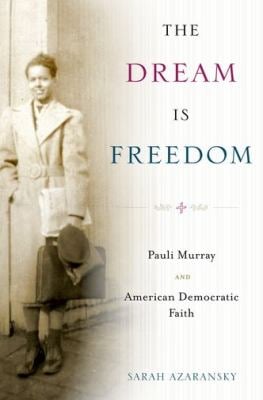Saint Pauli
Today's guest post comes from Dr. Sarah Azaransky, author of The Dream Is Freedom: Pauli Murray and the American Democratic Faith (Oxford University Press).
 A combative,
chain-smoking pixie on the wrong side of history is the not the typical profile
of a saint, yet this is how Pauli Murray described herself. Last month the Episcopal Church admitted Murray
to the pantheon of “Holy Women, Holy Men: Celebrating the Saints” in honor of her
efforts toward “the universal cause of freedom.”
A combative,
chain-smoking pixie on the wrong side of history is the not the typical profile
of a saint, yet this is how Pauli Murray described herself. Last month the Episcopal Church admitted Murray
to the pantheon of “Holy Women, Holy Men: Celebrating the Saints” in honor of her
efforts toward “the universal cause of freedom.”
The first
African American woman ordained an Episcopal priest, Pauli Murray (1910-1985) was
so much more. Lawyer, poet, memoirist,
polemicist, expat constitutional law professor in Ghana, co-founder of NOW,
mentor to Ruth Bader Ginsburg, and friend to Eleanor Roosevelt, Murray forged
intersections between American movements for black freedom, peace, and women’s
liberation.
Early
examples come from the 1940s when Murray was on the leading edge of new kind of
engagement with racial justice. She lived in the Harlem Ashram, an interracial
community that aspired to develop a Gandhian movement in the U.S. The Ashram
was a meeting place for James Farmer, Bayard Rustin, and Murray, among others,
who experimented with sit-ins and freedom rides. Ashram alumni were on the
planning team for CORE’s 1947 Journey of Reconciliation, which tested
compliance with the Supreme Court’s 1946 decision in Morgan v. Virginia. Riders hoped to demonstrate integral
connections between peace and black freedom, but Murray thought they should do
even more.
 Murray and Ella
Baker, the other woman on the planning team, wanted to ride, but, citing
safety, the group decided against it. Murray bristled. As the veteran of her
own 1940 arrest on a Virginia bus and as the organizer of successful sit-ins in
Washington DC in’43 and ’44, Murray was experienced in nonviolence.
Murray and Ella
Baker, the other woman on the planning team, wanted to ride, but, citing
safety, the group decided against it. Murray bristled. As the veteran of her
own 1940 arrest on a Virginia bus and as the organizer of successful sit-ins in
Washington DC in’43 and ’44, Murray was experienced in nonviolence.
She urged
her male colleagues to recognize entangling injustices. In a 1947 article she
developed the category Jane Crow to describe discrimination as a result of
racism and sexism. Murray distinguished Jane Crow from white women’s and black
men’s concerns, for, she wrote “within this framework of ‘male supremacy’ as
well as ‘white supremacy,’ the Negro woman finds herself at the bottom of the
economic and social scale.”
In 1964, she
used Jane Crow in her successful lobbying to have “sex” added to equal
protection standards of Title VII of the Civil Rights Act. Some opposed the
addition of “sex,” because it would distract from the bill’s primary purpose—to
end discrimination against African Americans. But Murray revealed this as a
false choice. Including “sex” in Title VII would
protect black workers, because, like Murray herself, many black workers were
women. Murray’s work to shape antidiscrimination law anticipated later
engagements by critical race feminists, particularly Kimberlé Crenshaw’s work
on intersectionality.
(Sadly, antidiscrimination law has not worked the way Murray
intended. The number of people making multiple claims—discrimination on the
basis of two or more factors, e.g. race and sex—is growing, but recent studies
of anti-discrimination law have found that multiple claims are all but
impossible to win.)
These few examples show why the Episcopal Church calls Murray a
“holy woman:” Murray’s universalist vision enabled her to constitute the
freedom struggle in new ways.
Yet sainthood entails its own risks. A saint is, by definition, an individual
(while the Nobel Committee recognizes collaboration, for the Church moral
perfection remains an individual achievement), and this can obscure how
communities form the saint. In Murray’s
case, the Harlem Ashram is a formative community. Another is the tradition of
black women’s leadership in liberation movements. In a sermon Murray compared Hagar
(enslaved by Abraham and Sarah and exiled with her son to the desert) to
Harriet Tubman, Sojourner Truth, and Dr. Mary McLeod Bethune, who—like Hagar—found
a way out of the wilderness. When the
Church elevated Murray, it signaled this lineage of African American women
freedom fighters in Murray’s moral formation.
Another risk
of sainthood: it minimizes failures and contradictions. When she was living in
Ghana in 1960, Murray was alone among U.S. expatriates in extolling the
possibilities of American constitutionalism. She falsely prioritized the
possibility of American democracy over its bloody realities. At the end of the
decade, she struggled to find common ground with Brandeis students who
commandeered the building that housed her office. Critiquing their tactics,
Murray overlooked how these students drew from internationalism,
Pan-Africanism, and calls for black self-determination, which had animated
Murray’s own student activism.
Regardless
of these imperfections, it’s exciting to have a black, pacifist, feminist
lawyer-priest as a new American saint. For more about Pauli Murray and how her
legacy contributes to the contemporary common freedom struggle in her hometown
of Durham, North Carolina check out the Pauli Murray Project
(paulimurrayproject.org).

Comments